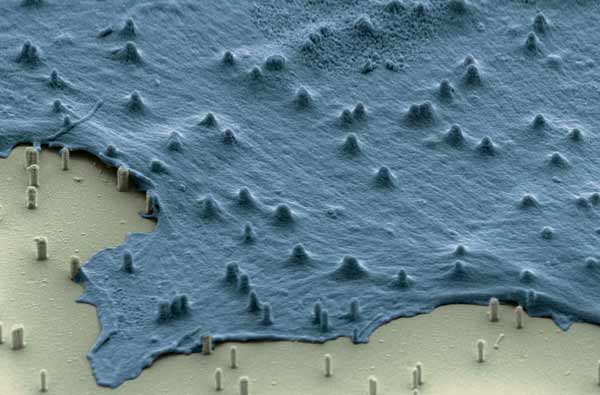Look What Those God Damned Infidels Are Up To
While the Islamic world continues apace on it's 1300 year odyssey of murdering, raping, and pillaging, the Infidels nerds are figuring out how to reshape life at the molecular level through the use of Nanowires.
Hell, I don't even understand what a Nanowire is, and yet I know this is some amazing shit.
Prediction; in the future, we won't even have to do away with the Jihadis, we'll just create another dimension, and move them the fuck into it. Then, they can just stay there and murder each other.
Anyway, check this out, from Al Fin:
Test Bed for Radical Evolution of Cells

Author Hongkun Park, a professor of chemistry and physics at Harvard University, says that, in theory, "you can put more or less any molecule in more or less any kind of cell." If the method proves effective, it could greatly speed the ability to manipulate cells in a variety of applications, including stem-cell reprogramming and drug screening.
Park's lab recently discovered that cells can be grown on beds of vertical silicon nanowires without apparent damage to the cells. The cells sink into the nanowires and within an hour are impaled by the tiny spikes. Even resting on this bed of needles, cells continue to grow and divide normally. This setup makes it possible to directly interface with the cell's interior through the nanowires. "Since we now have direct physical access, we can deliver molecules into cells without the restrictions of other techniques that are available," Park says. He adds that while his lab has found that many different types of cells seem to accommodate the tiny wires without negative effects, further studies will be needed to examine whether any important cell behaviors are affected.
To use the nanowires to deliver molecules, Park's team first treated them with a chemical that would allow molecules to bind relatively weakly to the surface of the nanowires, then coated the wires with a molecule or combination of molecules of interest. When cells are impaled on the nanowires, the molecules are released into the cells' interior. The chemical treatment of the wires could potentially be manipulated to control the binding and release of molecules--releasing them more slowly, for instance--and the wires can be constructed at different lengths to reach different parts of the cell. To demonstrate the method's flexibility, the team used the approach to deliver chemicals, small RNA molecules, DNA, and proteins into a range of cell types.
The beds of nanowires can be arranged on microarrays suitable for rapid experiments and imaging cells under a microscope. These microarrays can be "printed" with different patterns or combinations of molecules, making it possible to test many different molecules at once on an array of cells. The authors believe it could be possible to screen 20,000 different proteins or other chemicals on cells within a single microscopic slide.
...Thorsten Schlaeger, a stem-cell researcher at Children's Hospital Boston, is investigating the potential of the approach for reprogramming stem cells. His lab is interested in turning embryonic and induced pluripotent stem cells into blood stem cells like those found in the bone marrow. Currently, this task requires infecting cells with a virus to introduce new genes into their DNA, and, Schlaeger says, "there's no good alternative right now." Schlaeger's team is looking for better ways to manipulate cells, as well as ways to screen stem cells for factors that can transform them from one cell type to another. "It's hard to say what will be possible because it's new, but it's intriguing," he says._TechnologyReview
Early applications of the technology will include micro-arrays for high-throughput drug testing, and other rapid screening applications. But the technology virtually screams "rapid evolution"!
Imagine growing complex neural networks onto such test beds -- which are equipped to inject and extract both a wide range of molecular materials, but also various types of electromagnetic stimuli. The idea would be to grow entire cortical columns on a 3 dimensional implementation, then to connect the cultured cortical columns together one at a time -- all the while closely monitoring every aspect of the chemical, genetic, and electrophysiological functioning of the complex networks.
That is just the beginning. And what a simple idea.
- Say What You Want, But The Ingenuity Lives
A camera-attached laboratory microscope: $2,500. An imaging chip, a smartphone, and some Lego blocks: $400.Scientists at Caltech, out to ruin microscope manufacturers, have built their own device to monitor cells growing in a Petri dish. The device –...
- Only In Israel
A new treatment that destroys HIV-infected human cells without damaging healthy ones has been developed by a team of Israeli researchers.Researchers at Hebrew University of Jerusalem may have made a major step forward in the race against AIDS.The therapy,...
- Great Moments In The History Of Technological Innovation
The Infidel World vs. The Muslim World First, the Infidel World, from Al Fin: Genetics Magic: Two Examples of a Startling Future Here are two fascinating examples of genetics magic: Brain cells from skin cellsSkin cells called fibroblasts...
- Researchers Create Efficient, Recyclable Solar Cells From Trees
Researchers from Georgia Institute of Technology‘s Center for Organic Photonics and Electronics (COPE), in collaboration with Purdue University have unveiled a new efficient, recyclable organic solar cell made from trees—or, more specifically, from...
- Could We Finally Power Cars With Solar Panels?
Article originally published on dailymail in July 20th 2015. Nanowire technology may allow new types of hydrogen fuel cell for vehiclesScientists created a grid of tiny wires of gallium phosphide to split waterThis harnessed the sun's energy...
